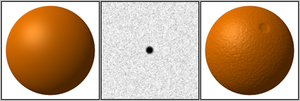
Bump mapping[1] is a texture mapping technique in computer graphics for simulating bumps and wrinkles on the surface of an object. This is achieved by perturbing the surface normals of the object and using the perturbed normal during lighting calculations. The result is an apparently bumpy surface rather than a smooth surface, although the surface of the underlying object is not changed. Bump mapping was introduced by James Blinn in 1978.[2]
Normal mapping is the most common variation of bump mapping used.[3]
- ^ "Bump and Environment Mapping" (PDF). ics.uci.edu.
- ^ Blinn, James F. "Simulation of Wrinkled Surfaces", Computer Graphics, Vol. 12 (3), pp. 286-292 SIGGRAPH-ACM (August 1978)
- ^ Mikkelsen, Morten (2008). "Simulation of Wrinkled Surfaces Revisited" (PDF). p. 7 (Section 2.2). Archived (PDF) from the original on 2019-05-26. Retrieved 2011-08-05.